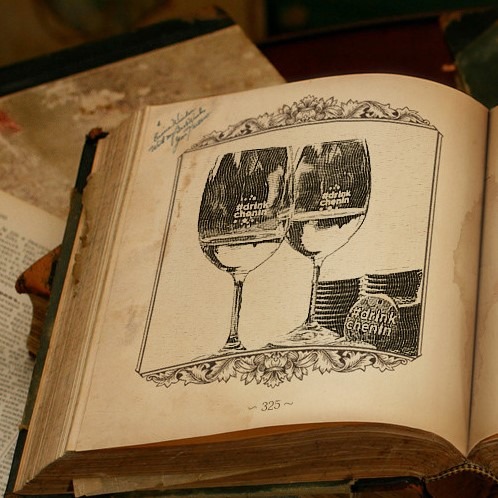基本送料は、配達地域で異なります。
なお、セット販売やキャンペーンコードで値引きの場合がございます。
Blog
2023/12/09 11:54
前回のブログに引き続き、南アフリカのシュナンブラン協会のホームページで「シュナンブランの歴史」がわかり易く掲載されていましたので、翻訳しましたので、参考までにご紹介します。なお、長文につき、その要約を最初に記して、本文を加えています。また、原文とその引用元のリンクを貼っています。
*:自分は翻訳家ではないので、誤訳があることを前提にお読みください。
<要約>
シュナン・ブランに関する歴史的な情報の要約です:
<845年>
フランスのロワール渓谷において「シュナン・ブラン」が最初に文献に登場し、15世紀にはロワール渓谷で広く栽培されるようになった。
<1145年>
修道院がアンジュー=ソーミュールのブドウ畑を発展させ、ヘンリー2世の時代にアンジューのワインが王宮で供されるようになった。
<1655年>
南アフリカに導入され、ヤン・ファン・リーベックの指導の下で初めてワインが造られた。
<1688年>
ユグノー教徒の亡命者がフランスから南アフリカに移住し、ワイン産業に貢献しました。
<1829年>
オーストラリアにも伝わり、南アフリカでは1950年代までにシュナン・ブランが広く栽培され、主力品種となった。
<1988年>
この頃までに、南アフリカワイン産業の主力品種となり、ブランデー蒸留にも使用された。
<2000年>
シュナン・ブラン協会が設立され、品質向上と古いブドウ畑の保護が目標とされた。

<2014年>
南アでスタンダード・バンク・シュナン・ブラン・チャレンジが開催され、賞金は農場労働者や地域社会のプロジェクトに使われる。
<2022年>
シュナン・ブラン国際会議が南アフリカとロワール渓谷で初めて開催され、2024年に第3回が予定されている。
------------------------------------- 以下、詳細 -----------------------------
845年 (ロワール渓谷 フランス)
プラント・ダンジュ "の名で最初に文献に登場するのは、845年にシャルル・ル・ショーヴによって書かれたエッセイで、フランスのロワール渓谷にあるサン・モール・ド・グランフイユ修道院に寄贈したことが明記されています。この品種は、15世紀にロワール渓谷のトゥーレーヌ地方に持ち込まれた後すぐに、モン・シュナンにちなんでシュナン・ブランと改名された。
1145年(フランス)
修道院はアンジュー=ソーミュールのブドウ畑を発展させる上で重要な役割を果たした。1154年にヘンリー2世がイングランド王になると、王宮ではアンジューのワインが供されるようになった。ヘンリーが父の死後、アンジューとメーヌの領有者となったからである。その結果、葡萄畑は16世紀から17世紀にかけて、ロワール河畔にあった最初の場所から増えていった。
1655年 喜望峰(南アフリカ)
シュナン・ブランは、ヤン・ファン・リーベック総督の時代、1655年にこの地に持ち込まれた最初の挿し木のブドウの一種と考えられている。ヤン・ファン・リーベックの監視の下、1659年2月2日、3本の若木から初めてブドウが収穫され、14.5リットルのワインが造られた。そのブドウの品種は、現在ではシュナン・ブランと呼ばれているステンドリューフ(Steendruif)と、当時はスパーン・ドゥルイヴェン(Spaanse druiven)と呼ばれていたハネフット(Hanepoot)、またはマスカット・ダレクサンドリー(Muscat d'Alexandrie)と名付けられた。
1688年(南アフリカ)
1688年、フランスのユグノー教徒がナントの版図撤回後に亡命してくると、何世代にもわたるワイン造りの経験を携えてワイン業界に転機が訪れた。彼らの貢献は、ブドウとワインの品質向上の基礎となった。
1829年 (スワン・ヴァレー オーストラリア)
1829年、イギリスの植物学者トーマス・ウォーターズ(Thomas Waters)が、南アフリカから挿し木したシュナン・ブランのブドウの木をスワン・ヴァレーに植え、翌年、オーストラリア最古のワイナリーであるオリーブ・ファーム(Olive Farm)のセラーを建設した。
1950年代(南アフリカ)
南アフリカのシュナン・ブランは、ケープで盛んに栽培されるようになり、地元のブドウ栽培者に好まれるようになった。 栽培が容易で、病気や風に強く、収量も多かった。1950年代までに、シュナン・ブランはケープで最も広く栽培されるようになり、ブドウ農家はこぞってシュナン・ブランのために最良のブドウ畑を確保した。
1963年(ステレンボッシュ 南アフリカ)
初期の意見では、スティーンはゲルマン起源であるとされていました。その証拠に、サイモン・ファン・デル・ステル総督がワインの品質について書いた手書きのメモには、スティーンから造られたワインはドイツの高品質な シュタインワインに匹敵すると書かれていました。これにより、ゲルマン語の綴り「Stein」が導入された。1963年、当時のステレンボッシュ大学のブドウ栽培責任者であったC.J.オルファー教授は、スティーンとシュナン・ブランの葉を比較し、最終的にスティーン種はシュナン・ブラン種と判明した。
1964年(ステレンボッシュ 南アフリカ)
1964年、ステレンボッシュ・ファーマーズ・ワイナリー(Stellenbosch Farmers Winery)のブランド、リーバースタイン(Lieberstein)が、3,100万リットルの世界最大の販売量を記録する白ワインの頂点に立った。 シュナン・ブラン・ノーブル・レイト・ハーヴェストであるネダーバーグ・エデルクールは、シュナン・ブランがもたらす品質の高さを十分に物語るものであった。
1988年(南アフリカ)
1988年までに、シュナンは栽培面積で全土のブドウ畑の33.2%を占め、ワインの生産量ではおそらくそれを上回った。 高い収量と過剰生産により、シュナンは南アフリカワイン産業の主力品種となり、ブランデー蒸留のベースワインとして使用されるようになった。それ以来、シュナンは毎年最も広く栽培されている品種となり、現在ではシュナンの栽培面積は南アフリカの栽培面積の18%と安定している。 現在も南アフリカで最も広く植えられている品種である。
2000年(南アフリカ)
シュナン・ブラン協会は2000年に設立され、2つの主な目標を掲げている。1つは、ブドウ園とセラーの両方でシュナン・ブランの品質を向上させることを特に目的とした研究を推進することで、それまでの大量生産に重点を置くのではなく、品質の高いブドウの生産に切り替えることである。第二に、貴重な古いブドウ畑を特定し、その根こそぎを可能な限り防ぐことである。最も古いシュナン・ヴィンヤード10軒を認定し、その栄誉を称えた。
2010年以降、南アフリカのワインメーカーは、高品質のシュナン・ブランを生産することに新たに注力するようになった。
2014年(南アフリカ)
第1回スタンダード・バンク・シュナン・ブラン・チャレンジが開催された。 このチャレンジの目的は、南アフリカのトップ・シュナンのワイン造りを特定し、それに褒章を与えることである。主催者とスポンサーは、受賞ワインを生産する上で、農場で働く人々がいかに重要であるかを認識していた。そのため毎年、上位10名の生産者全員に賞金が贈られるが、その賞金は農場労働者やその家族、地域社会を向上させるプロジェクトに使われることが条件となっている。
2022(南アフリカ・フランス)
シュナン・ブラン国際会議(CBIC)は、世界の2大シュナン産地である南アフリカとロワール渓谷が初めて一堂に会する国際会議で、2019年7月にアンジェで開催された。 南アフリカのステレンボッシュでは、2022年11月に「シュナン、場所の啓示者」というテーマで第2回が開催された。 第3回は2024年7月にフランスのアンジェ市で開催される予定である。
引用元:
Chenin Blanc Association公式サイトより
845 Loire Valley FRANCE
The first reference under the name of “ plant d’Anjou”, was in an essay written by Charles le Chauve in 845, stipulating that he gave it to Saint-Maur de Glanfeuil Abbey, in the Loire Valley, France. The variety was renamed Chenin Blanc, after Mont Chenin, in the 15th century soon after being exported to the Touraine region in the Loire Valley.
1145
The monasteries played a vital role in developing the Anjou-Saumur vineyards, as each had its own enclosed plot of vines. When Henry II became King of England in 1154, the royal court started to serve Anjou wines, as Henry became Count of Anjou and Maine upon the death of his father. As a result, the vineyards increased during the 16th and 17th centuries from their first location on the banks of the Loire.
1655 Cape of Good Hope
Chenin Blanc is believed to be amongst the first vine cuttings that arrived here in 1655 during the time of Governor Jan van Riebeeck.
Under the watchful eye of Jan van Riebeeck, on 2 February, 1659 the first grapes from three young vines were pressed, and produced fourteen and a half litres of wine. The grape varieties were named as steendruif, now known to be Chenin blanc, and hanepoot, or Muscat d’Alexandrie then called Spaanse druiven, or Spanish grapes.
1688
The arrival of the French Huguenots in 1688, in exile after the Edit de Nantes Revocation, marked a turning point for the wine industry bringing with them generations of experience of wine making. Their contribution was fundamental to the improvement in quality of the grapes and wine.
1829 Swan Valley AUSTRALIA
The Australian Wine Industry was launched in Western Australia when the English botanist, Thomas Waters, planted Chenin Blanc vine cuttings from South Africa in the Swan Valley in 1829 and the following year dug the cellar of Olive Farm, Australia’s oldest winery.
1950‘
Chenin Blanc in South Africa emerged as the favourite of local grape growers as it thrived at the Cape. It was easy to grow, disease and wind resistant and generated high yields. By the 1950’s it was by far the most widely planted grape in the Cape and each farm reserved their best vineyard sites for Chenin Blanc.
1963 Stellenbosch SOUTH AFRICA
Early opinion had it that Steen was of Germanic origin, supported by the evidence of a handwritten note, by Governor Simon van der Stel, on wine quality, that mentioned that wine made from Steen was comparable to quality German Stein wines. This saw the introduction of the Germanic spelling 'Stein'. In 1963, the then Head of Viticulture at the University of Stellenbosch, Professor C.J Orffer, matched Steen and Chenin Blanc leaves and finally pronounced Steen, Chenin Blanc.
1964
1964 saw the crowning of the Stellenbosch Farmers Winery brand, Lieberstein the world’s largest-selling white wine with 31 million litres, made almost entirely of Chenin with varying additions of other white wines. At a different level, but just as spectacular, Nederburg Edelkeur, a Chenin Blanc Noble Late Harvest, provided ample evidence of the quality that Chenin Blanc can deliver.
1988
By 1988, Chenin accounted for 33.2% of the national vineyard in terms of the area covered and probably higher than that in terms of volume of wine produced. High yields and overproduction led to it being declared the workhorse of the SA wine industry, used at the base wine in the distillation of brandy. Since then Chenin has become the most widely uprooted variety each year, with the area under Chenin now a stable 18% of South African plantings. It remains the most widely planted variety in South Africa.
2000
In 2000 the Chenin Blanc Association was formed, with two main goals, namely to promote research specifically aimed at improving the quality of Chenin Blanc both in the vineyard and in the cellar with a change to production of quality grapes instead of the previous emphasis on volume production. Secondly to identify valuable old vineyards and to prevent their uprooting as far as possible. The 10 oldest Chenin Vineyards were identified and celebrated.
2010 onwards has seen a new focus by South African winemakers to produce quality Chenin Blanc.
2014 SOUTH AFRICA
The inaugural Standard Bank Chenin Blanc Challenge took place in 2014. Its purpose is to identify and reward top Chenin winemaking in the country. The organisers and sponsors recognise how important farm workers are to producing these winning wines. That's why every year a cash prize goes to every one of the top ten producers with the condition that the money is spent on projects to uplift or upskill farm workers, their families and their communities.
2022
The Chenin Blanc International Congress (CBIC) was the first-ever congress brought together by the two largest Chenin regions in the world, South Africa and the Loire Valley and was held in Angers in July 2019. Stellenbosch, South Africa hosted the second edition, in November 2022 with the theme "Chenin, Revealer of Place". The third edition is scheduled for July 2024 in the city of Angers, France.
